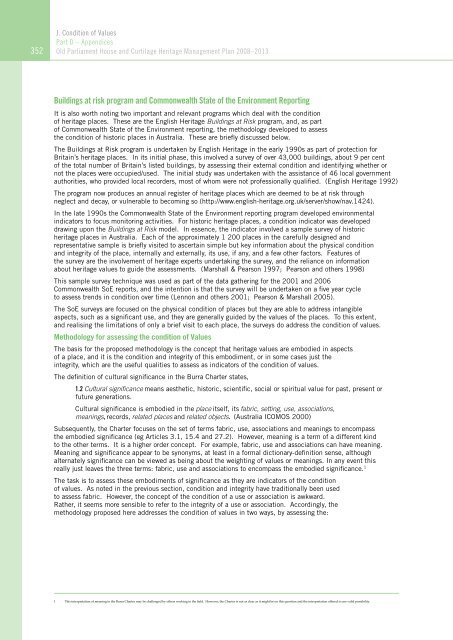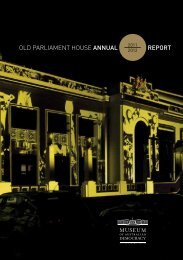OLD PARLIAMENT HOUSE AND CURTILAGE HERITAGE MANAGEMENT PLAN 2008–2013
Heritage Management Plan 2008-2013 - Museum of Australian ...
Heritage Management Plan 2008-2013 - Museum of Australian ...
- No tags were found...
You also want an ePaper? Increase the reach of your titles
YUMPU automatically turns print PDFs into web optimized ePapers that Google loves.
J. Condition of Values<br />
Part D – Appendices<br />
352 Old Parliament House and Curtilage Heritage Management Plan <strong>2008–2013</strong><br />
Buildings at risk program and Commonwealth State of the Environment Reporting<br />
It is also worth noting two important and relevant programs which deal with the condition<br />
of heritage places. These are the English Heritage Buildings at Risk program, and, as part<br />
of Commonwealth State of the Environment reporting, the methodology developed to assess<br />
the condition of historic places in Australia. These are briefly discussed below.<br />
The Buildings at Risk program is undertaken by English Heritage in the early 1990s as part of protection for<br />
Britain’s heritage places. In its initial phase, this involved a survey of over 43,000 buildings, about 9 per cent<br />
of the total number of Britain’s listed buildings, by assessing their external condition and identifying whether or<br />
not the places were occupied/used. The initial study was undertaken with the assistance of 46 local government<br />
authorities, who provided local recorders, most of whom were not professionally qualified. (English Heritage 1992)<br />
The program now produces an annual register of heritage places which are deemed to be at risk through<br />
neglect and decay, or vulnerable to becoming so (http://www.english-heritage.org.uk/server/show/nav.1424).<br />
In the late 1990s the Commonwealth State of the Environment reporting program developed environmental<br />
indicators to focus monitoring activities. For historic heritage places, a condition indicator was developed<br />
drawing upon the Buildings at Risk model. In essence, the indicator involved a sample survey of historic<br />
heritage places in Australia. Each of the approximately 1 200 places in the carefully designed and<br />
representative sample is briefly visited to ascertain simple but key information about the physical condition<br />
and integrity of the place, internally and externally, its use, if any, and a few other factors. Features of<br />
the survey are the involvement of heritage experts undertaking the survey, and the reliance on information<br />
about heritage values to guide the assessments. (Marshall & Pearson 1997; Pearson and others 1998)<br />
This sample survey technique was used as part of the data gathering for the 2001 and 2006<br />
Commonwealth SoE reports, and the intention is that the survey will be undertaken on a five year cycle<br />
to assess trends in condition over time (Lennon and others 2001; Pearson & Marshall 2005).<br />
The SoE surveys are focused on the physical condition of places but they are able to address intangible<br />
aspects, such as a significant use, and they are generally guided by the values of the places. To this extent,<br />
and realising the limitations of only a brief visit to each place, the surveys do address the condition of values.<br />
Methodology for assessing the condition of Values<br />
The basis for the proposed methodology is the concept that heritage values are embodied in aspects<br />
of a place, and it is the condition and integrity of this embodiment, or in some cases just the<br />
integrity, which are the useful qualities to assess as indicators of the condition of values.<br />
The definition of cultural significance in the Burra Charter states,<br />
1.2 Cultural significance means aesthetic, historic, scientific, social or spiritual value for past, present or<br />
future generations.<br />
Cultural significance is embodied in the place itself, its fabric, setting, use, associations,<br />
meanings, records, related places and related objects. (Australia ICOMOS 2000)<br />
Subsequently, the Charter focuses on the set of terms fabric, use, associations and meanings to encompass<br />
the embodied significance (eg Articles 3.1, 15.4 and 27.2). However, meaning is a term of a different kind<br />
to the other terms. It is a higher order concept. For example, fabric, use and associations can have meaning.<br />
Meaning and significance appear to be synonyms, at least in a formal dictionary-definition sense, although<br />
alternately significance can be viewed as being about the weighting of values or meanings. In any event this<br />
really just leaves the three terms: fabric, use and associations to encompass the embodied significance. 1<br />
The task is to assess these embodiments of significance as they are indicators of the condition<br />
of values. As noted in the previous section, condition and integrity have traditionally been used<br />
to assess fabric. However, the concept of the condition of a use or association is awkward.<br />
Rather, it seems more sensible to refer to the integrity of a use or association. Accordingly, the<br />
methodology proposed here addresses the condition of values in two ways, by assessing the:<br />
1 This interpretation of meaning in the Burra Charter may be challenged by others working in the field. However, the Charter is not as clear as it might be on this question and the interpretation offered is one valid possibility.




